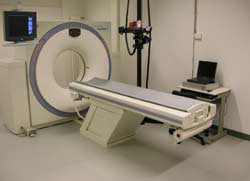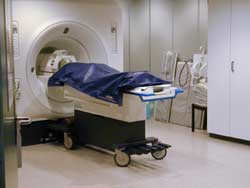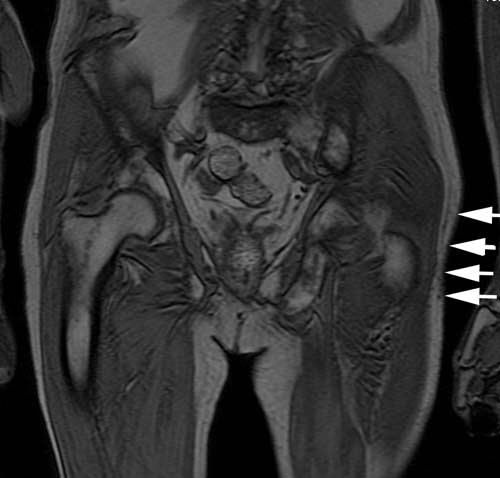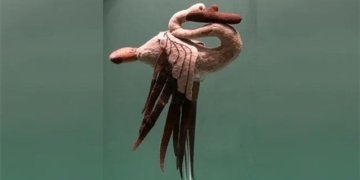A technique combining magnetic resonance imaging and scanning methods, traditionally used for living individuals, has now been adapted for performing autopsies on corpses without the need for surgical incisions.
 |
Scanner Machine (Photo: Virtopsy) |
In the rooms designated for corpses, a technical revolution has begun in the form of incision-free autopsies. Known as Virtopsy, this method is considered the most successful in Switzerland, originating from the idea of Professor Gil Brogdon, head of the forensic department at the University of Alabama, USA.
In 1998, Gil alerted his colleagues to his concerns about the declining state of forensic science, as he noted a significant decrease in the number of forensic doctors and researchers skilled in studying corpses to clarify causes of death.
To facilitate the work of those who persist in this field, he proposed modernizing tools by incorporating medical imaging techniques. Gil’s warning resonated all the way to Bern, Switzerland, where the Virtopsy project for conducting surgery without incisions was launched.
Professor Georges Léonetti, a forensic doctor at La Timone University Hospital in Marseille, affirmed: “It is clear that analyzing corpses has always been a process that should not be conducted only once.” This is similar to archaeological excavation.
Swiss forensic scientists have made giant strides. It must be noted that they have access to favorable resources and funding, with a technical foundation and imaging equipment available 24/7 dedicated entirely to this work. As a result, in the past three years, hundreds of incision-free autopsies have been performed, and approximately 50 articles have been published in reputable international forensic journals.
 |
| A corpse wrapped in a transparent covering being scanned (Photo: Virtopsy) |
This advancement is clearly appealing: the speed, cleanliness, accuracy, the ability to transmit images via the Internet, and remote analysis with other experts in cases of suspicion… Not to mention other benefits such as: safety when the corpse poses a risk of disease transmission, ease of handling in cases where autopsy is refused for religious reasons, and producing less shocking images.
In summary, “a very Swiss hygiene perspective,” comments Dr. Franck Clarot, a forensic doctor and radiology expert at Rouen Hospital.
In Toulouse, France, Dr. Fabrice Dedouit is the first forensic expert to take a serious interest in this field. With the approval of the Attorney General of the Toulouse Court of Appeal, he conducted the first French study on incision-free autopsy methods by applying scanning techniques (sometimes using MRI) on about 40 corpses, before proceeding with traditional autopsy methods.
Like his Swiss colleagues, he appreciates the quality of images obtained, as they provide very accurate information about the injuries sustained by the victims.
Dr. Dedouit clarifies: “First and foremost, imaging allows for diagnosing subjects without direct intervention. In cases of gunshot wounds, hanging, direct bone trauma, or in corpses that are decomposing, burned, or deformed due to gases released during decomposition, imaging clearly facilitates forensic work. Because traditional autopsy has its limitations.
For forensic doctors, the primary goal is diagnosis, but in practice, many situations can raise questions. For instance, a case of embolism due to gas, meaning gas in the bloodstream or heart. In this very specific case, an autopsy must be performed by opening the chest underwater to observe the bubbles rising. But clearly, this can only be done if there’s already suspicion.

Images obtained from scanning (Photo: Virtopsy)
Dr. Dedouit further explains: “Corpses are always wrapped in covering sheets that allow radiation to penetrate, thus avoiding the need to remove the body for imaging tests.” Not to mention the need for sterilizing rooms after examinations.
Incision-free autopsies also raise many less scientific issues. Firstly, economic concerns. On average, conducting a full-body scan and MRI is significantly more expensive than a traditional autopsy, sometimes by up to 300 euros. Furthermore, ethical and legal debates also arise. We need to question the persuasive value of the data provided. If we present a jury with “gentler” evidence, their reactions will differ. However, the reality remains a reality. Therefore, one must be mindful of the inductive nature of subjectivity.
Nevertheless, this new method has found its supporters. For several months, National Geographic has been inviting online submissions for incision-free autopsy of a mummified Inca girl discovered in Peru in 2004.
Minh Thu



















































